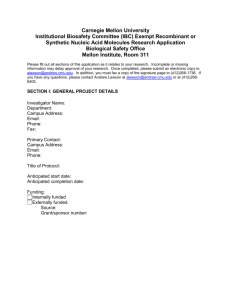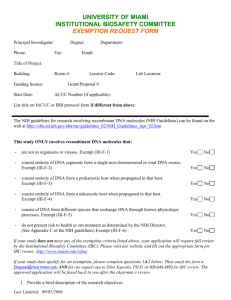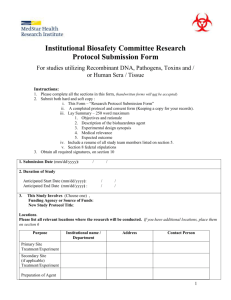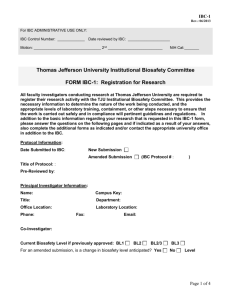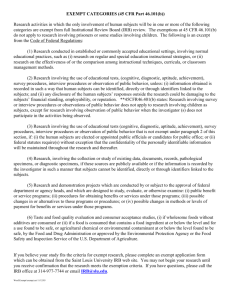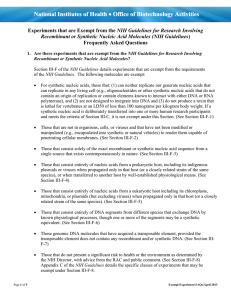Registration of Exempt Recombinant DNA Experiments and
advertisement
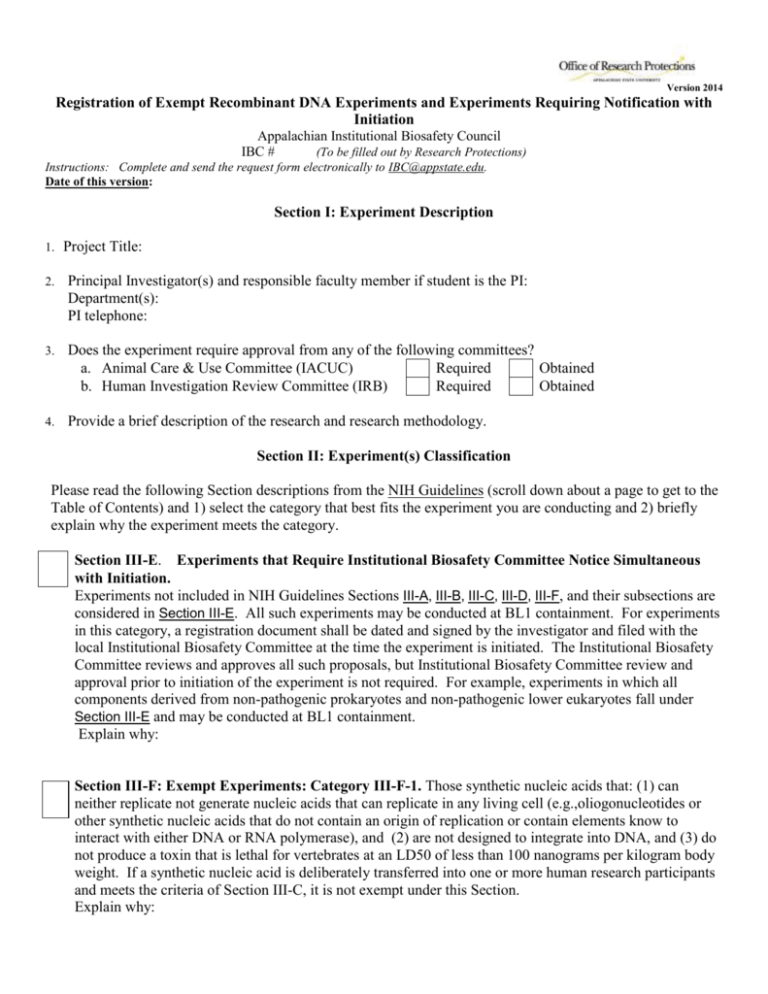
Version 2014 Registration of Exempt Recombinant DNA Experiments and Experiments Requiring Notification with Initiation Appalachian Institutional Biosafety Council IBC # (To be filled out by Research Protections) Instructions: Complete and send the request form electronically to IBC@appstate.edu. Date of this version: Section I: Experiment Description 1. Project Title: 2. Principal Investigator(s) and responsible faculty member if student is the PI: Department(s): PI telephone: 3. Does the experiment require approval from any of the following committees? a. Animal Care & Use Committee (IACUC) Required Obtained b. Human Investigation Review Committee (IRB) Required Obtained 4. Provide a brief description of the research and research methodology. Section II: Experiment(s) Classification Please read the following Section descriptions from the NIH Guidelines (scroll down about a page to get to the Table of Contents) and 1) select the category that best fits the experiment you are conducting and 2) briefly explain why the experiment meets the category. Section III-E. Experiments that Require Institutional Biosafety Committee Notice Simultaneous with Initiation. Experiments not included in NIH Guidelines Sections III-A, III-B, III-C, III-D, III-F, and their subsections are considered in Section III-E. All such experiments may be conducted at BL1 containment. For experiments in this category, a registration document shall be dated and signed by the investigator and filed with the local Institutional Biosafety Committee at the time the experiment is initiated. The Institutional Biosafety Committee reviews and approves all such proposals, but Institutional Biosafety Committee review and approval prior to initiation of the experiment is not required. For example, experiments in which all components derived from non-pathogenic prokaryotes and non-pathogenic lower eukaryotes fall under Section III-E and may be conducted at BL1 containment. Explain why: Section III-F: Exempt Experiments: Category III-F-1. Those synthetic nucleic acids that: (1) can neither replicate not generate nucleic acids that can replicate in any living cell (e.g.,oliogonucleotides or other synthetic nucleic acids that do not contain an origin of replication or contain elements know to interact with either DNA or RNA polymerase), and (2) are not designed to integrate into DNA, and (3) do not produce a toxin that is lethal for vertebrates at an LD50 of less than 100 nanograms per kilogram body weight. If a synthetic nucleic acid is deliberately transferred into one or more human research participants and meets the criteria of Section III-C, it is not exempt under this Section. Explain why: Section III-F: Exempt Experiments: Category III-F-2. Those are not in organisms, cells, or viruses and that have not been modified or manipulated (e.g., encapsulated into synthetic or natural vehicles) to render them capable of penetrating cellular membranes. Explain why: Section III-F: Exempt Experiments: Category III-F-3. Those that consist solely of the exact recombinant or synthetic nucleic acid sequence from a single source that exists contemporaneously in nature. Explain why: Section III-F: Exempt Experiments: Category III-F-4. Those that consist of nucleic acids from a prokaryotic host, including its indigenous plasmids or viruses when propagated only in that host (or a closely related strain of the same species), or when transferred to another host by well-established physiological means. Explain why: Section III-F: Exempt Experiments: Category III-F-5. Those that consist entirely of nucleic acids from a eukaryotic host including its chloroplasts, mitochondria, or plasmids (but excluding viruses) when propagated only in that host (or a closely related strain of the same species). Explain why: Section III-F: Exempt Experiments: Category III-F-6. Those that consist entirely of DNA segments from different species that exchange DNA by known physiological processes, though one or more of the segments may be a synthetic equivalent. A list of such exchangers will be prepared and periodically revised ty the NIH Director with advice of the RAC after appropriate notice and opportunity for public comment (see Section IV-C-1-b-(1)-(c), Major actions). See Appendices A-I through A-VI, Exemptions under Section III-F-6--Sublists of Natural Exchangers, for a list of natural exchangers that are exempt from the NIH Guidelines. http://osp.od.nih.gov/sites/default/files/resources/77_FR_54584.pdf Explain why: Section III-F: Exempt Experiments: Category III-F-7. Those genomic DNA molecules that have acquired a transposable element provided the transposable element does not contain any recombinant and/or synthetic DNA. Explain why: Section III-F: Exempt Experiments: Category III-F-8. Those that do not present a significant risk to health or the environment (see Section IV-C-1-b-(1)-(c), Major Actions), as determined by the NIH Director, with the advice of the RAC, and following appropriate notice and opportunity for public comment. See Appendix C, Exemptions under Section III-F-8 for other classes of experiments which are exempt from the NIH Guidelines. Explain why: 2 Section III: Research Personnel and Location of Research Enter each team member (including PI) in the table below. Add additional rows as necessary by right clicking on a row. (Note: Personnel changes can be submitted via email with the information below) Name Role (e.g., PI, co-I, Research Assistant, Research Cord., Faculty Advisor, etc.) Receive IBC Correspondence (Y/N)? If yes, provide preferred email address. 1. Describe how personnel have been trained in the handling of agents to be used (e.g., hands on training in the lab, lab meeting etc.). 2. List the building and room number in which the recombinant DNA experiments will be conducted: Section IV: Source of Funding and Conflict of Interest 1. Source of Funding: Not Funded Federally Funded Funds Awarded University Funded: describe Funds Pending If funds awarded/pending, provide sponsor name, Sponsored Programs number: Attach a copy of the contract/grant/agreement. 2. Are there any known or potential conflicts of interest related to this research? Conflict of interest relates to situations in which financial or other personal considerations may compromise or involve the potential/have the appearance for compromising an employee’s objectivity in meeting University responsibilities including research activities. Examples of conflicts of interest include but are not limited to: an investigator has equity in a business that conducts research in a related area; an investigator will receive an incentive/bonus based on the number or speed of enrollment or outcome of a study; or an investigator or family member is a consultant, holds an executive position or serves as a board member of the research sponsor or its holdings. No Yes, describe and explain how the potential conflict of interest will be managed. By submitting this request, the Principal Investigator (and responsible faculty member if PI is a student) accepts responsibility for ensuring that: 1. all members of the research team are sufficiently trained on the necessary practices and techniques to ensure safety and the procedures for dealing with accidents; 2. protocols that describe the potential biohazards and the precautions to be taken are available to all members of the research team; 3. all members of the research team are informed of the reasons and provisions for any precautionary medical practices advised or requested (e.g., vaccinations or serum collection); and 3 4. the study procedures as described in the IBC approved application and the policies in Appalachian’s Policy on the Use of Recombinant DNA in Research and Teaching Laboratories are followed. The parties (i.e., the IBC and the Principal Investigator and responsible faculty member if PI is a student) have agreed to conduct this application process by electronic means, and this application is signed electronically by the Principal Investigator and by the responsible faculty member if a student is the PI. My name and email address together constitute the symbol and/or process I have adopted with the intent to sign this application, and my name and email address, set out below, thus constitute my electronic signature to this application. PI Name PI Email address __ ___ Responsible Faculty Name if PI is a student Responsible Faculty Email address if PI is a student 4
